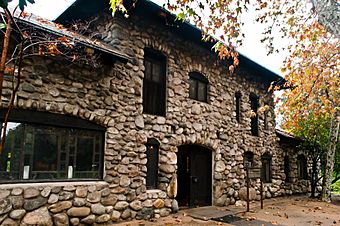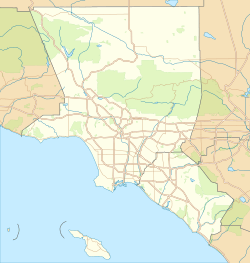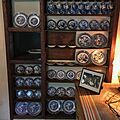Lummis House facts for kids
|
Lummis House
|
|

Lummis House in 2012.
|
|
| Location | 200 E. Ave. 43, Los Angeles, California |
|---|---|
| Area | 3 acres (1.2 ha) |
| Built | 1897 |
| Built by | Lummis, Charles F. |
| Architectural style | Rustic American Craftsman |
| NRHP reference No. | 71000148 |
Quick facts for kids Significant dates |
|
| Added to NRHP | May 6, 1971 |
Lummis House, also known as El Alisal, is a special stone house in Los Angeles, California. It was built by a famous person named Charles Fletcher Lummis a long time ago, between the late 1800s and early 1900s. The house is built in a style called "Rustic American Craftsman," which means it looks natural and handmade.
The house is located near the Arroyo Seco area in northeast Los Angeles. Its Spanish name, "El Alisal," means "alder grove." This name comes from the many alder trees that grew nearby. The Lummis House is recognized as a Los Angeles Historic-Cultural Monument and is also listed on the National Register of Historic Places.
Contents
History of Lummis House
Building El Alisal
Charles Lummis bought the land for his house between 1895 and 1897. The property was about 3 acres (1.2 hectares) in size. He named it "El Alisal" because of the many alder and sycamore trees growing in the nearby arroyo, which is a dry creek bed.
It took Lummis 13 years to build his 4,000-square-foot (370 square meter) home. He used river rocks and other natural materials. The house even had a special exhibition hall with a concrete floor. This made it easy to clean after parties with artists, writers, and musicians.
Famous Visitors and Community Work
Many well-known people visited or stayed in Lummis's guest houses. These guests included famous lawyer Clarence Darrow, entertainer Will Rogers, musician John Philip Sousa, and naturalist John Muir.
Lummis cared deeply about the natural beauty around his home. In 1905, he started the Arroyo Seco Foundation. This group worked to protect the natural habitat and encourage people to enjoy the area.
Changes Over Time
In 1940, the Arroyo Seco Parkway was built. This was the first freeway ever made. It was built between the Lummis House and a new flood control channel in the arroyo.
For many years, starting in 1965, the Historical Society of Southern California used the Lummis House as its main office. They also opened the house to the public for visits. However, in 2015, the Historical Society moved out. Today, the City of Los Angeles Recreation and Parks Department takes care of the Lummis House.
Lummis House as a Museum
Exploring the House
The City of Los Angeles now runs the Lummis House as a historic house museum. This means visitors can explore the house and learn about its history. The outside of the house is made of river rock. It once had a stone tower, but that was taken down later.
Inside the house, you can see some of the items Charles Lummis collected. There are also copies of many of the books he wrote. The museum is open for public tours, so you can visit and see it for yourself.
Gardens and Nature
The gardens around the Lummis House are very special. They mostly have drought-tolerant plants. This means the plants don't need much water to grow. Many of them are also California native plants. These are plants that naturally grow in California.
You can still see California Sycamore trees in the garden. These are the same type of trees that gave the house its name, "El Alisal."
California Historical Landmark Marker
A special sign, called a California Historical Landmark Marker, is located at the Lummis House. This marker, number 531, tells a bit about the house's history.
It says:
- NO. 531 LUMMIS HOME - This building was constructed by Charles F. Lummis (1859-1928). He was an author, editor, poet, athlete, librarian, historian, and archeologist. He chose this spot in 1895 mainly because of a huge, old sycamore tree called El Alisal. That original tree has since died, but four new young sycamore trees have been planted in its place.
Gallery
See also
 In Spanish: Casa Lummis para niños
In Spanish: Casa Lummis para niños











